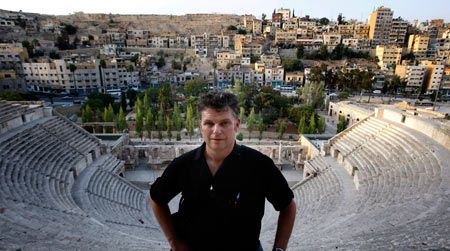Paul Daley chats with Jessica Au about his new book,

Canberra
When my initial excitement at being invited to write Canberra subsided into reality I was overwhelmed. But I did what I always do with a big non-fiction piece – immersed myself in the research. That meant a lot of time in the archives. I knew from experience that if I dug deep enough, I’d find the voices, past and present, which could give life to narrative.
It also meant exploring my city with a new eye – talking to those who had fantastic stories about the past, often handed down through generations. For years I’d been researching the camps where the workers (many of them damaged World War I veterans) who built the city, lived. The tent camps were in a valley where the lake now is. They lived in harsh conditions, with much drinking and violence. I’d always thought perhaps I’d use those stories in fiction some day. Instead, they made Canberra.
I was also drawn to the stories of the pioneering settlers of the Limestone Plains, with their tales of bushrangers and natural disaster. I managed to dispel the odd myth about them along the way. I was especially drawn to the stories of the original inhabitants, the Ngambri people, their fate after white settlement – and their important link to the naming if the city in 1913. And that was just to set the scene for the last fifty years.
You write early on of the cultural cringe surrounding the city; its perceived bureaucracy and ‘benign dullness’. Why do you think Canberra is viewed this way by so many?
It’s always been the case. Politics has heavily compromised Canberra since well before even its location or name were settled upon. Only four federal politicians actually live here, yet ‘Canberra’ is a euphemism for all political negatives – simply because the government meets here for 20 weeks a year, and because the bureaucracy that serves it is embedded here. The cringe also goes to a pervasive sense that bureaucracy – the public service – is intrinsically worthless and boring because, mostly, it does not generate wealth. I think it seems like an anathema to so many outsiders that a highly intelligent, diverse community and a rich culture actually thrive here. It annoys me that outsiders with little experience of the place claim a right to bag Canberra and its people in a way they never would another Australian city.
*The book also tells of how Canberra is not in fact the city of architect Walter and Marion Burley Griffins’ original vision – but rather a hybrid of it, a product of politicking and design-by-committee. Do you feel that there is still some tragedy in this lost ideal? *
The story of how the Griffins’ plan for Canberra (it was envisaged as the ideal city for a new democracy) was undermined, really is a personal – and town planning – tragedy. Most Australians would say Canberra is the Griffins’ city. But really we just got the Griffin outline that we can still see from the tops of Mount Ainslie and Red Hill today; the conservative, anglophile planners and bureaucrats weren’t courageous enough to build or pay for such a bold vision as that articulated in Marion Mahony Griffin’s exquisite drawings. We have, perhaps, a third of what they planned. But miraculously, the complex symbolism of Australian democracy - as envisaged by the Griffins – still has some integrity in the Canberra of today. Australia’s cultural story is etched into Canberra’s landscape.
Your research unearths several fascinating asides about the city’s history – what was your favourite discovery along the way? Did it make it into the book?
I have two favourites. Firstly, that the willow trees that proliferate here are direct descendants of those at Napoleon’s original grave at St Helena, and, second, that the first bottle-oh into the Westlake workers’ camp collected more than two million empties. Canberra was built on grog. Both just had to make the final edit.
You write movingly of your own complex relationship with the city, and your return to it as a political journalist. What makes a city home?
It’s a great question. We (probably) only go around once. When we ‘live’ in a city we invest our lives in it. It’s where we’ve toiled, loved, lamented, grown up, grown old and perhaps died. Because it’s where the present unfolds, it becomes host to our memories. Memory is powerfully emotive. Of course it’s also about family and friends. For me an intense, almost spiritual affinity with the urban and natural landscape and the stories embedded there is more important than real estate. That’s home.
Finally, tell us about the books or writers that you’ve loved in the past.
At school it was the classics like Austen and Dickens. I still read Great Expectations every few years. Then, as a teenager, I discovered George Johnston. I loved the way he wrote about place and challenged the conservative orthodoxies and clichés of post-colonial Australia in the David Meredith trilogy. He’s why I became a journalist and an author. I’m constantly re-reading modern Australian fiction from David Ireland and Helen Garner to Tim Winton, Craig Sherbourne, Tom Keneally, Mark Dapin and Frank Moorhouse, of whom I’m a big fan. I like early Martin Amis and anything by Richard Ford and Ian McEwan. Any Human Heart by William Boyd is one of my all-time favourite novels. In non-fiction it’s hard to go past Antony Beevor. Reading Christopher Hitchens showed me the imperative in non-fiction of taking a corner and fighting it.
Canberra
A book by Booki.sh


